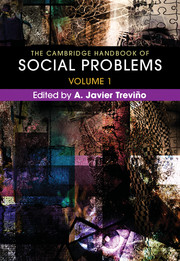Book contents
- The Cambridge Handbook of Social Problems
- The Cambridge Handbook of Social Problems
- Copyright page
- Contents
- About the Contributors
- Introduction
- Part I General Concerns and Orientations in the Study of Social Problems
- Part II Historical and Theoretical Issues in the Study of Social Problems
- Chapter 11 Settlement Sociology
- Chapter 12 Chicago School: City as a Social Laboratory
- Chapter 13 Luhmann's Sociological Systems Theory and the Study of Social Problems
- Chapter 14 The Conflict Approach
- Chapter 15 Radical Interactionism and the Symbolism of Methamphetamine
- Chapter 16 Social Constructionism
- Part III Problems of Discrimination and Inequality
- Part IV Problems of Institutions
- Index
- References
Chapter 16 - Social Constructionism
from Part II - Historical and Theoretical Issues in the Study of Social Problems
Published online by Cambridge University Press: 16 March 2018
- The Cambridge Handbook of Social Problems
- The Cambridge Handbook of Social Problems
- Copyright page
- Contents
- About the Contributors
- Introduction
- Part I General Concerns and Orientations in the Study of Social Problems
- Part II Historical and Theoretical Issues in the Study of Social Problems
- Chapter 11 Settlement Sociology
- Chapter 12 Chicago School: City as a Social Laboratory
- Chapter 13 Luhmann's Sociological Systems Theory and the Study of Social Problems
- Chapter 14 The Conflict Approach
- Chapter 15 Radical Interactionism and the Symbolism of Methamphetamine
- Chapter 16 Social Constructionism
- Part III Problems of Discrimination and Inequality
- Part IV Problems of Institutions
- Index
- References
Summary
This overview of social constructionism begins with a consideration of the influential work of Malcolm Spector and John I. Kitsuse, whose book Constructing Social Problems inspired a wide variety of studies addressing how social problems are “constructed.” Ensuing epistemological and methodological controversies are discussed, and three key scholarly works are reviewed for the insights they offer into exemplary analytic practice in a constructionist vein. The exemplars pivot around the notion that “understanding understandings” is essential to executing constructionist analysis and does not entail subscribing to reified conceptions of objective conditions. The chapter concludes by discussing three promising directions for extending the constructionist purview, namely, through the study of (1) cyberspace (including social media) as an emerging but essential venue for the construction of social problems; (2) claimsmaking in national contexts beyond the Anglo Global North, especially in countries that challenge the liberal democratic assumptions upon which constructionist scholarship usually rests; and (3) a broadened, more quotidian conception of the social spaces and forms through which social problems–related expression is advanced.
- Type
- Chapter
- Information
- The Cambridge Handbook of Social Problems , pp. 279 - 300Publisher: Cambridge University PressPrint publication year: 2018
References
- 11
- Cited by



